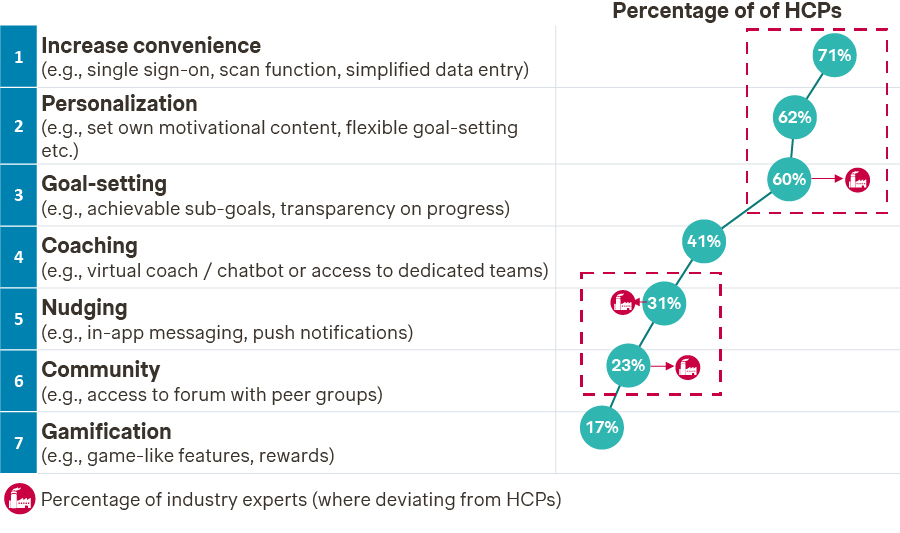Patients don’t want one-off care services. And so, top healthcare providers are already making the shift from transactional to long-term patient-provider relationships. In the last edition of our 3-part series, we explore how subscription models and digital engagement tools can keep patients connected, loyal, and invested.
Patient retention is more cost-effective than acquisition. It’s the turning point for long-term success, cultivated through loyalty. Above all, it’s a marker of trust. According to Reichheld and Sasser’s classic insight, a 5% boost in customer loyalty can lead to a 25% to 85% increase in measurable outcomes over time. In healthcare, that translates to more than financial advantage and it’s a powerful reminder that trust and long-lasting relationships drive success.
Earning loyalty takes work, but digital patient engagement helps
Loyalty in healthcare is built over countless interactions. As digital interactivity becomes integral to healthcare decisions, every online touchpoint shapes loyalty and influences patient retention. In other words, digital patient engagement isn’t just a way to improve patient access or convenience, but it’s an effective lever for providers to build retention and loyalty at scale.
This is where healthcare providers often face significant challenges. The current market is very competitive and patients have many choices when one provider falls short of their expectations. Digital engagement solutions help hospitals to proactively and personally engage with patients and develop trust to stand out in the market.
What are the primary drivers of loyalty?
- Trust: In healthcare, this is the foundation of every relationship. It influences how patients perceive care, make decisions, and engage with their providers.
- Personalization: When patients feel understood and see their individual needs are addressed, it strengthens loyalty. Tailored communication and services show patients they are valued.
- Offer and price models: Smart pricing strategies also help build loyalty. Flexible options - like memberships, packages, or subscriptions – offer clear value and incentivize patients to stay committed.
Why trust is the first step to patient loyalty - and retention
Price transparency and online access to inspire trust
Patients are more likely to stay when they have clarity around cost and care quality. Digital platforms enable both online healthcare access and price transparency – two important factors for patients. Leading digital health providers meet these expectations with instant online bookings, clear pricing, and simple service descriptions. Traditionally, providers have relied on opaque pricing with complex billing structures, but simplified and transparent upfront costs help build trust and increase conversion. With digital platforms, there are no lengthy administrative processes. Just simple booking and payment online.
Integrated patient journeys to strengthen retention
Consistency and connectivity benefit both patients and providers. A centralized, accessible platform supports proactive health management and smoother communication – reducing friction in how patients access care. Integrating essential services such as appointment scheduling and prescription tracking into a single digital solution helps patients navigate their care journey more easily. When every touchpoint is connected, patients feel supported, informed, and in control. That sense of continuity builds trust and makes them more likely to return.
Personalization is a loyalty driver in modern healthcare
Tailored communication to keep patients invested
Good healthcare encompasses clear, honest, and targeted communication. It’s no longer a nice-to-have. According to our Digital Health Trend Study, 62% of healthcare professionals believe personalized communication is essential for patient outreach today. In the first article of the series, we discussed a European diagnostic lab provider’s success using personalized messages and automated reminders to reduce missed appointments. This significantly improved the care plan compliance. The lab network also uses its digital engagement solution to quickly handle follow-ups, prescription requests, and referrals. This continues to enhance the patient experience and lowers the risk of them switching providers. Patients are far more responsive to relevant information than to generic information outreach. Tailored communication helps reduce anxiety, especially for patients managing long-term health issues.

Key success factors in product design to increase patient engagement.
Simon-Kucher Digital Health Trend Study 2022, study sample: HCPs: n = 257, Industry experts: n = 60
Tailored wellness programs to improve health outcomes
Leading providers are also applying personalization to wellness programs to support long-term health goals. Competitive services and packages go beyond one-size-fits-all care. With digital patient engagement, key health data and patient preferences are available on one platform. This helps providers build customized wellness programs that reflect individual interests and health goals. From nutrition counseling and fitness classes to mental health support and chronic disease management, these offerings prioritize preventive care and long-term well-being.
How the right offer and pricing models encourage patient retention
Flexible subscriptions that build patient loyalty
The best patient loyalty programs and incentives reinforce connectivity, value, and trust. To be truly flexible, subscription models today must combine virtual care with in-person services - giving patients more control over their care and encouraging repeat visits. AUS-based skincare provider discovered this firsthand when it introduced tiered treatment packages for acne. Patients can choose from three options: a single session, three-visit bundle with skincare products, or six-visit package. Each bundle is paired with digital booking, automated reminders, and pre-/post-care instructions. After the introduction of these subscription plans, patients began committing to multiple treatments more easily. The skincare provider now has fewer barriers when it follows up with patients. To deepen that value, well-designed loyalty programs can enhance these subscriptions with reward elements. By recognizing (and rewarding) health-positive behaviors, like regular check-ups and screenings, providers can keep patients engaged over a long period. Perks such as discounts on future visits and personalized add-ons tailored to their subscription can turn occasional users into long-term members.
Gamification that drives long-term engagement
For patients managing long-term health conditions, consistent attention to their daily recovery routine is essential. Healthcare gamification makes care engaging and fun. Patients can earn points, unlock badges, and track progress alongside other app users. These features not only keep them engaged but also help reinforce positive health behaviors in a way that is rewarding and interactive. A medical research center and provider of clinical and hospital care from the US integrated leaderboards and social sharing to keep participation high and engaging, with points redeemable for discounts on future treatments or exclusive benefits like priority scheduling.
How to design subscription models that are engaging for patients and viable for providers?
In healthcare, as in most other industries, subscription-based monetization is emerging as a strategic imperative. Digital patient engagement platforms can carry subscription options for general health memberships, chronic disease management, rehabilitation programs, and preventive care. But what are the critical factors that determine whether these models deliver sustained value?
Patient-centric design
Each subscription package must be carefully designed with patient needs, preferences, and health conditions in mind. When the experience works for patients, the business benefits will follow. Personalization done right builds trust and drives long-term engagement. Patient-centric design helps keep the offerings – and the provider – top of mind and relevant.
Clear value proposition
Successful subscription offerings meet diverse patient needs. When developing subscription tiers, it’s critical to build them around a value proposition that reflects the varying expectations and willingness to pay across patient segments. Each tier should deliver tangible benefits that patients feel outweigh the price. It’s one of the key factors in whether patients choose to continue their relationship with the provider.
Integration with existing systems
Seamless technical integration is equally important. This guarantees ease-of-use and scalability for subscription models with growing usage. The digital engagement platform supporting these packages should connect effortlessly with key systems, like automated billing, telehealth services, patient records, etc., to provide a smooth experience for both patients and providers.
Measurable outcomes and metrics
Define clear KPIs from the start. The right performance metrics must capture clinical impact and business performance: patient retention rates, engagement levels, subscription renewal rates, and revenue growth. Qualitative data (perceived value of services, digital use) reveals how well the model aligns with patient needs. A robust metrics framework not only enables continuous performance monitoring and identifies opportunities for improvement but also supports decision-making for future service design and scaling.
Are you ready to commit to these steps and thrive?
Patient loyalty and sustainable business growth depend on how providers engage and reward patients.
Now is the time to examine where your business stands with current patient engagement strategies and identify areas for improvement. We work closely with healthcare providers to put all these strategies into action. We help you:
- Define patient segmentation and targeting strategies for digital services.
- Design patient engagement journeys for seamless digital experiences.
- Develop loyalty and retention programs to maximize patient lifetime value.
- Define performance tracking frameworks to measure impact on revenue, patient base, and engagement.
Let us work together to digitize your healthcare services and improve patient engagement. Contact us today for an in-depth discussion.




